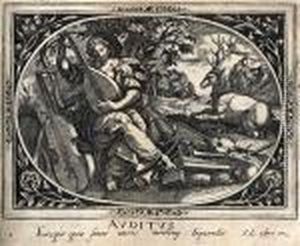Thomas De Leu Paintings
Thomas De Leu, also known as Thomas de Leeuw or Théodore de Léu, was a prominent French engraver and printmaker born around 1560 in the Southern Netherlands, which is present-day Belgium. He moved to Paris, France, where he became an influential figure in the world of art during the late 16th and early 17th centuries. De Leu is particularly noted for his portrait engravings and book illustrations, which played a significant role in the dissemination of the visual culture of his time.
De Leu's body of work includes a wide range of subjects, from portraits of important figures of his era to mythological and religious scenes. He was part of the vibrant artistic milieu in Paris, engaging with publishers, poets, and scholars, which allowed him to contribute to various important publications of the period. His style is characterized by meticulous detail and a keen sense of realism, attributes that made his works highly sought after for illustrating books and for standalone prints.
Among his notable works are the portraits of Queen Elizabeth I of England and King Henry IV of France, showcasing his skill in capturing not only the physical likeness but also the essence of his subjects. De Leu's engravings were not only artistic achievements but also served as important historical documents, providing contemporary and future generations with visual representations of key figures and events of his time.
Thomas De Leu's contribution to the art of engraving and the cultural landscape of the early modern period was significant. His works are preserved in various museums and collections worldwide, attesting to his enduring legacy. Despite his death in 1612, De Leu's influence persisted, with his techniques and stylistic approaches informing the practices of subsequent generations of engravers and printmakers.
